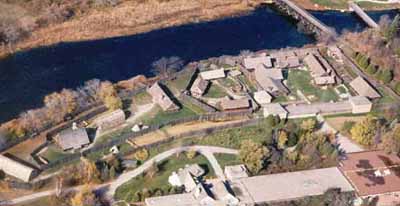Sainte-Marie Among the Hurons Mission National Historic Site of Canada
Midland, Ontario

Aerial view
© Huronia Historical Park, Rosemary Vyvyan & William Brodeur, 2005.
Address :
off Highway 12, Midland, Ontario
Recognition Statute:
Historic Sites and Monuments Act (R.S.C., 1985, c. H-4)
Designation Date:
1920-01-30
Dates:
-
1639 to 1649
(Significant)
Other Name(s):
-
Sainte-Marie Among the Hurons Mission
(Designation Name)
-
Fort Ste. Marie I
(Other Name)
-
Sainte Marie Among the Hurons
(Other Name)
-
Ste. Marie on the Wye
(Other Name)
-
Mission of Ste. Marie
(Other Name)
-
Sainte-Marie II
(Plaque name)
Research Report Number:
1988-042, 2007-CED-SDC-012
Plaque(s)
Existing plaque: at parking lot in front of museum entrance off Highway 12, Midland, Ontario
Founded by the Jesuits in 1639, Sainte-Marie was designed as a central residence for the mission to the Wendat (Huron) peoples. For a decade Sainte-Marie was a major French community, the earliest in what is now Ontario. Prolonged daily contact between native people and Europeans profoundly affected both groups. By the winter of 1648-1649, Huronia was so revaged by disease and conflict that the Jesuits abandoned and burned Sainte-Marie and with some Wendat followers moved to Christian Island. The following year the Jesuits and Hurons withdrew to Québec.
Description of Historic Place
Sainte-Marie Among the Hurons Mission National Historic Site of Canada is the former headquarters of the Jesuit Mission to the Huron-Wendat from 1639-1649. It is located under the site of the reconstructed 17th-century Jesuit mission on the banks of the Wye River, which flows into Georgian Bay near Midland, Ontario. The current site presents reconstructed European-style mission buildings, including barracks and workshops, and Iroquoian-type longhouses, all situated within a wooden palisade fortification.The designation refers to the site of the original mission and any archaeological evidence of it.
Heritage Value
Sainte-Marie Among the Hurons Mission was designated a national historic site of Canada in 1920 because it was headquarters of the Jesuit Mission to the Hurons from 1639-1649.
Founded by the Jesuits in 1639, Sainte-Marie was the centre for the mission to the Huron-Wendat peoples. The mission was built in the territory known as Huronia, which was inhabited by the Huron-Wendat, horticulturalists living in densely populated villages year-round. Christian Hurons visited Sainte-Marie for worship, and for medical treatment after the establishment of a hospital, but Sainte-Marie remained essentially a European enclave, the headquarters from which priests were sent out on missions to the individual villages. The mission developed into a sizeable colony, with chapel, hospital, residences, storehouses and workshops.
However, prolonged daily contact between native people and Europeans profoundly affected both groups. The Huronia had suffered from fatal outbreaks of smallpox and other European epidemic diseases. This resulted in intensified Iroquois attacks, along with social divisions and internal conflicts caused by conversions to Christianity. By the winter of 1648-1649, Huronia was so ravaged by disease and conflict that the Jesuits abandoned and burned Sainte-Marie and with some Wendat followers moved to Christian Island (previously known as Gahoendoe or Île-Saint-Joseph), establishing what is now known as Fort Sainte Marie II National Historic Site of Canada. In 1650, the Jesuits and Hurons withdrew to the location now called the Old Wendake Historic District National Historic Site of Canada, just north of Québec City.
Initial archaeological work began on the site in the 1840s and 1850s and then continued again during the 1940s and 1950s.This work informed the 1964 reconstruction of the buildings that once stood on the site.
Sources: Historic Sites and Monuments Board of Canada Minutes, October 1920, November 1988, May 2007.
Character-Defining Elements
Key elements contributing to the heritage value of this site include: the location of the settlement on the banks of the Wye River, which flows into Georgian Bay; viewscapes to and from the site and the river; all archaeological evidence discovered and as of yet undiscovered of the Jesuit-Wendat settlement during the 1639-1649 period.